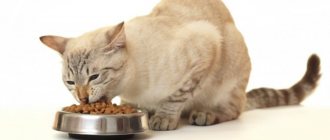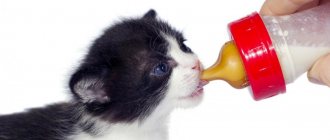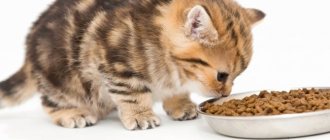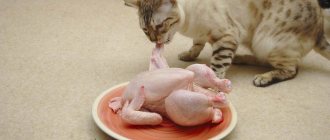By three months, your baby has already grown noticeably, certainly does not feed on his mother’s milk (the duration of lactation in a cat is about two months), and is quite ready to switch to adult food. Only the transition to a constant diet and a two-time feeding schedule must be carried out gradually, which will take about three months.
This period of a kitten’s life has its own characteristics, which must be taken into account when compiling its diet. He is already interested in everything that comes into view, and is not yet afraid of anything. This means that it moves a lot, climbs everywhere, it requires a huge amount of nutrients - after all, it also grows rapidly! You cannot limit a teenage kitten's food intake.
At about four months, teeth change begins. This process takes up to three months, although it can last up to eight months of age. For the most part, it does not cause inconvenience to either the animal or the owner. Moreover, owners do not always notice fallen teeth: they are very small, and kittens very often swallow them, which does not harm their health at all. Closer to six months, the pet should become familiar with many dishes of the adult diet.
What to feed a newborn kitten if he is left without a cat?
Previously, it was believed that kittens without mother's milk would die before they were one month old. Their body is not developed enough to accept cow's or goat's milk. And how, if the kitten has a developed sucking reflex, and he learns to lick only a month after birth.
Currently, in veterinary clinics you can buy a special mixture and a bottle for feeding small newborn animals. What to feed a newborn kitten if there is no clinic nearby? You can prepare the mixture yourself.
Mixture for newborn kittens : 10 ml low-fat cream, 4 ml glucose (sold at the pharmacy), 6 ml purified water (can be boiled). Chop.
Feeding a kitten
It is necessary to feed a kitten up to a month every 2 hours, give 2 ml of the mixture. If there is no feeding device, take a regular syringe without a needle. Drop it drop by drop while your baby sucks. After feeding, the kitten must be sent to the house from the blanket and the belly massaged like a cat so that the food is absorbed and the baby receives tactile contact to adapt to the outside world.
The importance of proper nutrition
If you have a small pet, you need to have an idea of how to properly and effectively feed a kitten in order to raise a healthy and happy animal.
The lack of a balanced diet affects the development and growth of the baby and can lead to physical disabilities, problems with internal organs and even death.
If the food is not selected correctly, this can lead to an allergic reaction in the young body, which can also affect the growth of the animal.
How often and what to feed a 1 month old kitten?
They try to give away baby kittens per month. At this age they are the cutest, and by this time they are already opening their eyes and starting to eat their first complementary foods. At this point, the kitten no longer needs its mother's milk as much as in the first weeks of life.
But what to feed a 1 month old kitten? Nutrition can be divided into two main areas: ready-made complementary foods and homemade food, which is more preferable for animals.
There is a lot of controversy regarding ready-made canned pet food sold in stores. Manufacturers assure that such food is completely safe and is recommended for animals as a balanced diet. Their opponents, on the contrary, are convinced that constant feeding of such products leads to a number of diseases.
Nutrition for kittens at 1 month
If you plan to feed your cat homemade food that you will prepare yourself, be sure to introduce the first complementary food, ground to a paste in a blender or through a sieve.
The first complementary food is cow's milk. Pour into a saucer and give it a try. After a few days you can cook your first porridge.
- Cook buckwheat, oatmeal, wheat or other porridge (do not cook rice, peas, pearl barley, beans) until it becomes boiled and sticky. Grind 10 g of porridge into puree. Add 5 ml of milk and stir until smooth. Give your baby a treat at lunchtime. Alternate cereals so that the kitten gets used to different tastes.
- 3 days after the successful introduction of cereals, treat your baby to vegetable puree. Do not give kittens nightshades (potatoes, eggplants, tomatoes, bell peppers). Start feeding your kitten with zucchini, cabbage (all types), and beets. Cats should not eat carrots. Boil the vegetables until fully cooked and grate. Give from 5 g, gradually increasing to 20 g at a time.
- When you give porridge with milk 2 times a day and vegetables 1 time a day, you can add cottage cheese with low-fat sour cream . Kittens love this food and eat it with pleasure. Cottage cheese with sour cream can be given from the 6th week of a kitten’s life, 5-10 g at a time, every other day.
- You need to alternate cottage cheese with boiled eggs . First, treat the kitten with half a yolk, and only after a week can you add the white. The ground egg can be smeared with sour cream so that the kitten quickly gets used to the new taste.
- Regarding the kitten's monthly feeding schedule . At the age of 4 weeks, kittens usually eat every 2-2.5 hours, the night is divided into two halves, including 1 meal. The rest of the time it is necessary to accustom the kitten to rest. He is still small and is not able to walk in the dark like an adult animal.
- Gradually transition the kitten to food every 3 hours . By 8 weeks, the kitten should eat once every 3-3.5 hours, one meal at night, as before.
Feeding standards
The amount of food per meal depends on its type and type of feeding. Veterinarians recommend keeping domestic cats on a natural diet, regularly using vitamin and mineral supplements, and following a two-time feeding regimen (morning and evening).
An adult healthy animal should be provided with at least 10 g of protein, 2 g of fat, 1 g of carbohydrates, 1 g of fiber per 1 kg of weight per day. The daily energy value for natural feeding should be at least 40 kcal per 1 kg of weight.
If the owner buys ready-made food for his fluffy dog, he must strictly adhere to the dosage indicated on the packaging. Finished products of different brands differ in the quality of raw materials, preparation technology, and composition. For example, for a healthy adult cat weighing 4 kg, the average amount of dry food per day is 60-70 g, divided into two meals.
Important! Depending on the composition of the feed, its purpose and class, the dosage may differ slightly for animals of the same weight category. The higher the product class, the lower the feed consumption
All ready-made food is completely balanced and nutritious. Premium, super-premium or holistic products undergo numerous quality checks, are safe for animals and are economical.
Super-premium and higher class food is most suitable for the animal
The main parameter by which the required amount of ready-made food per day is determined is the weight of the animal. To ensure full life activity, per 1 kg of adult weight there should be 30-60 g of food containing 60-70 kcal.
Below are tables showing how much dry and wet food a cat needs per day:
How much dry food do you need per day?
How often and what should I feed two-month-old kittens?
And now the kitten is two months old, the hardest part is over. Now the baby is fully eating from the bowl and the feeding equipment can be removed. So what to feed a kitten at two months? This period is transitional and fish and meat are added during this month. Please note that previously the kitten had enough protein from milk and dairy products. But he has grown up and the predator needs meat and fish.
- So you should have three bowls. A bowl of water is always there, and the kitten can drink water at any time. You need to wash the bowl and change the water once a day.
- The second bowl is with milk . Pour milk only when heated or at room temperature. The kitten's stomach is not able to fully digest cold milk, and it will have pain and cramps.
- The third bowl is food. It should only be used for meals. As soon as the kitten eats everything, remove and wash. This way, you will prevent him from getting poisoned by stale food and teach him to eat on time.
Nutrition for a 2 month old kitten
- In the period from 8 to 12 weeks of a kitten’s life, you need to switch it to feeding once every 4 hours , and at night, instead of a full meal, a portion of milk. You can leave it in the evening, the kitten is already able to find milk on its own in the dark, and you can already afford a regular night's sleep.
- Now regarding feeding fish. Boil the fish and remove the bones. Grind into a puree and add to vegetables, which you can start adding in pieces. For 30 g of vegetables add 7-10 g of fish puree. We administer it every other day at lunchtime or in the morning.
- After a week of feeding fish, you can begin to alternate with meat. Start with rabbit, chicken or duck. Do not forget to increase the portion to 30 g of meat or fish per day until three months.
- The liver is a budget storehouse of protein and many useful vitamins and microelements. Add it to your diet at least once a week.
Basic rules of care
Of course, you no longer notice the features of your home, but a new, unknown world, full of fears and smells, opens up for your kitten. Therefore, many kittens experience a real stressful feeling when moving to a new place of residence. And your task is to brighten up the first minutes and days in which the kitten will settle into the house.
There is no need to force your friendship on the kitten or introduce it to other family members. Believe me, when the time comes, the pet will take a step forward. The only thing you need to do is introduce the baby to the bowl, tray and bed.
At first, the bed will become the only stronghold in the kitten’s life, so try to make it as comfortable as possible. You can buy a bed for a kitten in an online store or in a specialized market, and if you don’t want to spend money, you can set up a mini den yourself. The most ordinary cardboard box is suitable for this purpose. Lay a few warm clothes inside it, and for the first time this will be enough. Place the box in a warm, draft-free place. Happy parenting!
How often and what should I feed three-month-old kittens?
In three months, the kitten has already grown significantly and is ready to switch to fewer meals. This month we feed the kitten 4 times a day, and between these meals we can treat him with milk.
What to feed three-month-old kittens? Every day the kitten's diet should include: porridge or vegetables, fish or meat, milk, eggs or dairy products. In this case, the proportionality should be as follows:
- 50% meat or fish;
- 30% milk and fermented milk products;
- 20% porridge or vegetables.
Remember that a kitten is a small predator. Its basis of nutrition is mother's milk, and then birds and mice. Starting from the 3rd month, you can treat kittens to pieces of raw meat. In the future, reach a mixed diet of prepared food and raw food.
Kittens at the bowl
Food portions by weight for a three-month-old kitten directly depend on the breed and size. On average, this is 50-100 g at a time.
Prohibited Products
According to the degree of allergenicity, all products can be divided into highly, moderately and lowly allergenic.
First of all, it is necessary to exclude everything fried, smoked, salted, spicy, as well as semi-finished meat and fish products - cutlets, sausages, fishburgers, sausage, as they contain a large amount of flavoring and aromatic additives and stabilizers.
List of prohibited products:
- Citrus fruits (oranges, tangerines, lemons, grapefruits).
- Nuts (hazelnuts, almonds, peanuts).
- Fish, seafood and fish products (fresh and salted fish, fish broths, canned fish, caviar).
- Poultry (goose, duck, chicken) and products made from them.
- Chocolate and chocolate products.
- Coffee.
- Smoked products.
- Vinegar, mustard, mayonnaise and spices.
- Horseradish, radish, radish.
- Tomatoes, eggplants, red peppers.
- Eggs and milk.
- Strawberries, wild strawberries, pineapple, grapes, melon, watermelon and other red and orange fruits.
- Pastry products, yeast.
- Honey.
- Alcoholic drinks.
How often and what to feed kittens aged 4-6 months?
From four months to six months, kittens are given three meals a day and snacks with milk. What to feed a kitten? In principle, up to this age, the kitten’s menu has been completely expanded and only a small part of the food remains to be added. From the 4th month, the kitten’s diet should be supplemented with offal, skins, and tendons.
Caring owners often neglect such “waste” from birds and animals, but they contain large amounts of amino acids:
- Arginine;
- Tryptophan;
- Isoleucine;
- Lysine;
- Phenylalanine;
- Histidine;
- Valin;
- Methionine;
- Threonine.
Without them, animals begin to develop early blindness, the hair becomes dull, and the animal becomes more lethargic and sick.
Meat is a mandatory ingredient for kitten menus
What to feed kittens aged 4-6 months? By 6 months of age, a kitten’s diet should contain:
- 70% meat or fish, including liver, skins, joints and tendons, offal;
- 30% vegetables and cereals.
Milk and dairy products can continue to be given as a snack, but not as a main meal.
What to feed a kitten: reviews
Reviews about
feeding kittens:
Anna : We found a baby on the street, it wasn’t a month old yet. They fed them with a mixture of cream and glucose, and after a week they added milk, cottage cheese, and sour cream. A little later, vegetables, cereals and meat and fish. Now furry Vaska is already six months old since we found him. Gorgeous cat, and so affectionate! The vet checked and said he was completely healthy.
Maryana : We bought a kitten for the children and didn’t even expect that it would be such a responsibility! The seller wrote us instructions on what to feed and how, but we only got our bearings at home. My husband and I took turns waking up at night, and during the day we heated food in tiny portions every 3 hours. At first they weighed him, they were afraid that he was not eating enough. But then we got used to it, we add a little more. While he is young and active, he walks thin, but the doctor said that if he starts to gain weight, give him portions according to the weight formula.
In conclusion, we suggest taking a look at our other articles about kittens and adult cats:
- Is it possible to leave a cat alone for a day, 5 days, a week, two weeks?
- At what age is it better to take a kitten of different breeds home: advice from a veterinarian;
- I can’t cope with death, the loss of a cat: what should I do?
- The cat abandoned the kittens and does not want to feed them. How and what to feed newborn kittens?
- How to cut a cat's hair at home? Cat haircuts: photos;
- Why does a cat breathe like a dog, sticking out its tongue?;
- Scottish Fold cat: character, features, description of the breed











